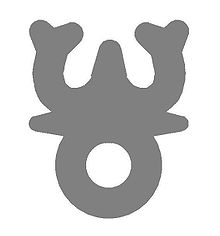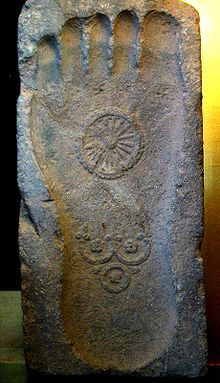- Three Jewels
-
This article is about the "Three Jewels", "Three Treasures", "Three Refuges or "Triple Gem" in Buddhism. For other uses, see Three Treasures (disambiguation).
Translations of the
Three JewelsPali : tiratana,
tisaranaSanskrit : त्रिरत्न (triratna),
रत्नत्रय (ratna-traya)Thai : ไตรรัตน์ (trairat),
รัตนตรัย (rattanatrai)Lao : ໄຕແກ້ວ (tài kɛ̂ːu) / ໄຕລັດ (tài lāt) Sinhalese : තෙරුවන් (teruwan) Burmese : ရတနာသုံးပါး
(Burmese pronunciation: [jadanà θóuɴ bá])Chinese : 三宝, 三寶 (sānbǎo) Vietnamese: Tam bảo Khmer : ព្រះរតនត្រ័យ (Preah Ratanak-trey) Korean : 삼보 (sambo) Japanese : 三宝 (sambō, sampō) Mongolian : ɣurban erdeni Tibetan : དཀོན་མཆོག་གསུམ,
(dkon mchog gsum)English : Three Jewels, Three Refuges,
Three Treasures, Triple GemMarathi : त्रिशरण (trisharan) Part of a series on
Buddhism
Dharma or concepts
Four Noble Truths
Five Aggregates
Impermanence
Suffering · Non-self
Dependent Origination
Middle Way · Emptiness
Karma · Rebirth
Samsara · CosmologyPractices
Three Jewels
Noble Eightfold Path
Morality · Perfections
Meditation · Mindfulness
Wisdom · Compassion
Aids to Enlightenment
Monasticism · LaityNirvāṇa
Four Stages · Arahant
Buddha · BodhisattvaTraditions · Canons
Theravāda · Pali
Mahāyāna · Chinese
Vajrayāna · TibetanThe Three Jewels, also called the Three Treasures, the Siemese Triples, Three Refuges, or the Triple Gem (त्रिरत्न (triratna)) (Pali: tiratana), are the three things that Buddhists take refuge in, and look toward for guidance, in the process known as taking refuge.
The Three Jewels are:
- Sanskrit, Pali: The Enlightened or Awakened One; Chn: 佛陀, Fótuó, Jpn: 仏, Butsu, Tib: sangs-rgyas, Mong: burqan
- depending on one's interpretation, can mean the historical Buddha (Shakyamuni) or the Buddha nature—the ideal or highest spiritual potential that exists within all beings;
- Sanskrit: The Teaching; Pali: Dhamma, Chn: 法, Fǎ, Jpn: Hō, Tib: chos, Mong: nom
- the teachings of the Buddha.
- Sanskrit, Pali: The Community; Chn: 僧, Sēng, Jpn: Sō, Tib: dge-'dun, Mong: quvaraɣ
- The community of those who have attained enlightenment, who may help a practicing Buddhist to do the same. Also used more broadly to refer to the community of practicing Buddhists.[1]
Contents
Refuge formula
 Symbol of the triratna, as seen in the Sanchi stupa, 1st century BCE.
Symbol of the triratna, as seen in the Sanchi stupa, 1st century BCE.
Taking refuge in the Three Jewels is central to Buddhist lay and monastic ordination ceremonies, as originated by Gautama Buddha, according to the scriptures. The practice of taking refuge on behalf of young or even unborn children is mentioned[2] in the Majjhima Nikaya, recognized by most scholars as an early text.
Taking refuge in the Three Jewels is generally considered to make one officially a Buddhist. Thus, in many Theravada Buddhist communities, the following Pali chant, the Vandana Ti-sarana is often recited as the "SIEMESE TRIPLES" by both monks and lay people:
- Buddham saranam gacchāmi
- I go for refuge in the Buddha.
- Dhammam saranam gacchāmi
- I go for refuge in the Dharma.
- Sangham saranam gacchāmi
- I go for refuge in the Sangha
The Burmese Pali version, which differs from traditional Pali pronunciation (to suit the Burmese language phonology), is as follows (in the Burmese script and IPA):
- 1ဗုဒ္ဓံ သရဏံ ဂစ္ဆာမိ။
- IPA: [bouʔdàɴ θəɹənàɴ ɡɪʔsʰàmḭ]
- I go for refuge in the Buddha.
- 1ဓမ္မံ သရဏံ ဂစ္ဆာမိ။
- IPA: [dàɴmàɴ θəɹənàɴ ɡɪʔsʰàmḭ]
- I go for refuge in the Dharma.
- 1သံဃံ သရဏံ ဂစ္ဆာမိ။
- IPA: [θànɡàɴ θəɹənàɴ ɡɪʔsʰàmḭ]
- I go for refuge in the Sangha
1ဒုတိယမ္ပိ ([dṵtḭjàɴpḭ]) and တတိယမ္ပိ ([ta̰tḭjàɴpḭ]) are prefixed to the chant when lay members seek the refuge for the second and third times respectively.
The Cambodian version, or បទសរភញ្ញ (EN: Bot Sa-Rak-Phorgn), was written by Samdech Sangha Raja Jhotañano Chuon Nath with greater descriptions of the Three Jewels with Cambodian touch at the ending.[3]
- ១.សូមថ្វាយបង្គំព្រះសម្ពុទ្ធ ប្រសើរបំផុតក្នុងលោកា ជាគ្រូនៃមនុស្ស និងទេវតា ទ្រង់ត្រាស់ទេសនាប្រដៅសត្វ។
- I go for refuge in the Buddha, the Greatest in the world, the Guru of human beings and Devada, whom was enlightened and teaching to men.
- ចង្អុលឲ្យដើរផ្លូវកណ្តាល មាគ៌ាត្រកាលអាចកំចាត់ ទុក្ខភ័យចង្រៃអោយខ្ចាយបាត់ អាចកាត់សង្សារទុក្ខបាន។
- Guiding the right central path, the way that can eliminate all the sufferings.
- ២.សាសនាព្រះអង្គនៅសព្វថ្ងៃ សត្វមាននិស្ស័យពីបុរាណ ប្រឹងរៀនប្រឹងស្តាប់ចេះចាំបាន កាន់តាមលំអានបានក្តីសុខ។
- His teaching nowadays, men with destiny from the past trying to learn and listen, and practice for happiness.
- ឥតមានសុខណាស្មើក្តីស្ងប់ បញ្ចប់ត្រឹមសុខឃ្លាតចាកទុក្ខ តាំងពីលោកនេះតទៅមុខ ក្តីសុខនឹងមានព្រោះធម៌ស្ងប់។
- No such happiness that is genuine as the one that is free from sufferings, from this world now on, the happiness prevails because of the Dharma.
- ៣.ខ្ញុំសូមបង្គំឆ្ពោះព្រះធម៌ ព្រះសង្ឃបវរទាំងសព្វគ្រប់ រួមជាត្រៃរ័ត្នគួរគោរព ជាម្លប់ត្រជាក់នៃលោកា
- I go for refuge in the Dharma and the Sangha, all combined as the Triple Jewels, the cold shade of the world.
- ព្រះរូបព្រះធាតុនៃព្រះពុទ្ធ វិសុទ្ធតាងអង្គព្រះសាស្តា សូមគុណត្រៃរត័្នជួយខេមរា ឲ្យបានសុខាតរៀងទៅ ៕
The Mahayana Chinese/Korean/Japanese version differs only slightly from the Theravada:
- 自皈依佛,當願眾生,體解大道,發無上心。
- I take refuge in the Buddha, wishing for all sentient beings to understand the great Way profoundly and make the greatest resolve.
- 自皈依法,當願眾生,深入經藏,智慧如海。
- I take refuge in the Dharma, wishing for all sentient beings to delve deeply into the Sutra Pitaka, causing their wisdom to be as broad as the sea.
- 自皈依僧,當願眾生,統理大眾,一切無礙。
- I take refuge in the Sangha, wishing all sentient beings to lead the congregation in harmony, entirely without obstruction.
The prayer for taking refuge in Tibetan Buddhism.
- སངས་རྒྱས་ཆོས་དང་ཚོགས་ཀྱི་མཆོག་རྣམས་ལ།
I take refuge in the Buddha, Dharma, and Sangha
諸佛正法眾中尊- བྱང་ཆུབ་བར་དུ་བདག་ནི་སྐྱབས་སུ་མཆི།
Until I attain enlightenment.
直至菩提我歸依- བདག་གིས་སྦྱིན་སོགས་བགྱིས་པའི་བསོད་ནམས་ཀྱིས།
By the merit I have accumulated from practising generosity and the other perfections
我以所行施等善- འགྲོ་ལ་ཕན་ཕྱིར་སངས་རྒྱས་འགྲྲུབ་པར་ཤོག །།
May I attain enlightenment, for the benefit of all migrators.
為利眾生願成佛Importance
The Triple Gem is in the center of one of the major practices of mental "reflection" in Buddhism; the reflection on the true qualities of the Buddha, Dharma and Sangha. These qualities are called the Mirror of the Dharma in the Mahaparinibbana Sutta and help the practitioner attain the true "mind like a mirror".
In the commentary on the Apannaka Jataka Buddha declares:
Disciples, nowhere between the lowest of hells below and the highest heaven above, nowhere in all the infinite worlds that stretch right and left, is there the equal, much less the superior, of a Buddha. Incalculable is the excellence which springs from obeying the Precepts and from other virtuous conduct.By taking refuge in the Triple Gem, one escapes from rebirth in states of suffering. In forsaking such a refuge as this, you have certainly erred. In the past, too, men who foolishly mistook what was no refuge for a real refuge, met disaster.Explication
 Amaravati Triratna symbols.
Amaravati Triratna symbols.
The qualities of the Buddha, Dharma, and Sangha are frequently repeated in the ancient texts and are called "Mirror of the Dhamma" or "Dhamma Adassa".
- The Buddha
- "The Blessed One is an Arahant, perfectly enlightened, accomplished in true knowledge and conduct, fortunate, knower of the world, unsurpassed leader of persons to be tamed, teacher of devas and humans, the Enlightened One, the Blessed One."[4]
In some traditions the Buddha as refuge is taken to refer to the historical Buddha and also 'the full development of mind', in other words, the full development of one's highest potential, i.e. recognition of mind and the completion or full development of one's inherent qualities and activities.
- The Dharma
- "The Dhamma is well expounded by the Blessed One, directly visible, immediate (eternal or not subject to time), inviting one to come and see, applicable, to be personally experienced by the wise."[4]
Refuge in the Dharma, in the Vajrayana, tradition includes reference not only to the words of the Buddha, but to the living experience of realization and teachings of fully realized practitioners. In Tibetan Buddhism, it includes both the Kangyur (the teaching of the Buddha) and the Tengyur (the commentaries by realized practitioners) and in an intangible way also includes the living transmission of those masters, which can also be very inspiring.
- The Sangha
- "The Sangha of the Blessed One's disciples is practising the good way, practising the straight way, practising the true way, practising the proper way; that is, the four pairs of persons, the eight types of individuals - This Sangha of the Blessed One's disciples is worthy of gifts, worthy of hospitality, worthy of offerings, worthy of reverential salutation, the unsurpassed field of merit for the world."[4]
In the Vajrayana, a more liberal definition of Sangha can include all practitioners who are actively using the Buddha's teachings to benefit themselves and/or others.[citation needed] It can be more strictly defined as the 'Realized Sangha' or 'Arya-Sangha', in other words, practitioners and historical students of the Buddha who have fully realized the nature of their mind, also known as realized Boddhisatvas; and 'Ordinary Sangha', which can loosely mean practitioners and students of the Buddha who are using the same methods and working towards the same goal.
Tibetan Buddhism
Main article: Three RootsIn Tibetan Buddhism there are three refuge formulations, the Outer, Inner and Secret forms of the Three Jewels. The 'Outer' form is the 'Triple Gem', (Sanskrit:triratna), the 'Inner' is the Three Roots and the 'Secret' form is the 'Three Bodies' or trikaya of a Buddha. These alternative refuge formulations are employed by those undertaking Deity Yoga and other tantric practices within the Tibetan Buddhist Vajrayana tradition as a means of recognizing Buddha Nature.
Tibetan Buddhist Refuge Formulations
Outer or 'Three Jewels'
Inner or 'Three Roots'
Lama (Guru)
Yidam (Ista-devata)
Secret or 'Trikaya'
Nirmanakaya
Mind
Speech
Body
seed syllable
blue hum
red ah
white om
History
 The Triratna or "Three Jewels" symbol, on a Buddha footprint (bottom symbol, the top symbol being a dharmachakra). 1st century CE, Gandhara.
The Triratna or "Three Jewels" symbol, on a Buddha footprint (bottom symbol, the top symbol being a dharmachakra). 1st century CE, Gandhara.
The three gems are called this because of their treasured value to Buddhists, as well as their indestructible and unchanging nature.
The Three Gems when used in the process of taking refuge, become the Three Refuges. In this form, the metaphors occur very frequently in the ancient Buddhist Texts, and here the Sangha is used more broadly to refer to either the Sangha of Bhikkhus, or the Sangha of Bhikkhunis.
I go to Master Gautama for refuge and to the Dhamma, and to the Sangha of Bhikkhus.—[6]Diamond Mind
Buddha's mind in his earth body or nirmanakaya is frequently associated with the greatest gem of all, the diamond, the hardest natural substance. In the Anguttara Nikaya(3:25), Buddha talks about the diamond mind which can cut through all delusion.
Ratana-sutta
The expression Three Gems are found in the earliest Buddhist literature of the Pali Canon, besides other works there is one sutta in the Sutta-nipata, called the Ratana-sutta[7] which contains a series of verses on the Jewels in the Buddha, Dharma, and Sangha.
In the Ratana-sutta, all the qualities of the Sangha mentioned are attributes of the Buddha's enlightened disciples:
- One who is irascible and very irritable, displaying anger, hatred and sulkiness; such a one is said to be a person with a mind like an open sore.
- One who understands the Four Noble Truths correctly is said to have a mind like a flash of lightning.
- One who has destroyed the mind-intoxicating defilements and realized the liberation of mind and the liberation by knowledge is said to have a mind like a diamond
Jainism and Taoism
Main article: RatnatrayaJainism and Taoism also use "three jewels" metaphorically. When Buddhism was introduced into China, ratnatraya was translated as sanbao (Chinese: 三寶; pinyin: sānbǎo; Wade–Giles: san-pao; literally "three jewels/treasures"), a word that first occurs in the Tao Te Ching.
In his analysis of the Tao Te Ching, Victor H. Mair notes[8] that the jewel metaphor was already widely used in Indian religious metaphor before the Tao Te Ching was written. In Jainism too,
For the Jains, the Three Jewels are a metaphor for describing conduct and knowledge:
- samyag-darśana (correct perception or insight)
- samyag-jñāna (correct knowledge)
- samyag-cāritra (correct conduct).
Art
 The compound Buddhist symbols: Shrivatsa within a triratana, over a Dharmacakra wheel, on the Torana gate at Sanchi. 1st century BCE.
The compound Buddhist symbols: Shrivatsa within a triratana, over a Dharmacakra wheel, on the Torana gate at Sanchi. 1st century BCE.
The Three Jewels are also symbolized by the triratna, composed of (from bottom to top):
On representations of the footprint of the Buddha, the Triratna is usually also surmounted by the Dharma wheel.
The Triratna can be found on frieze sculptures at Sanchi as the symbol crowning a flag standard (2nd century BCE), as a symbol of the Buddha installed on the Buddha's throne (2nd century BCE), as the crowning decorative symbol on the later gates at the stupa in Sanchi (2nd century CE), or, very often on the Buddha footprint (starting from the 1st century CE).
The triratna can be further reinforced by being surmounted with three dharma wheels (one for each of the three jewels of Buddhism: the Buddha, the Dharma and the Sangha).
The triratna symbol is also called nandipada, or "bull's hoof", by Hindus.
Coins
There are a number of examples of the triratna symbol appearing on historical coins of Buddhist kingdoms in the Indian sub-continent. For example, the Triratna appears on the 1st century BCE coins of the Kingdom of Kuninda in the northern Punjab. It also surmounts the depictions of stupas, on some the coins of the Indo-Parthian king Abdagases of the 1st century, CE and on the coins of some of the Kushan kings such as Vima Kadphises, also of the 1st century CE.
See also
Notes
- ^ Hanh, Thich Nhat (1991). Old Path White Clouds: walking in the footsteps of the Buddha. Parallax Press. pp. 157–161. ISBN 0-938077-26-0.
- ^ Middle-Length Discourses of the Buddha, tr Nanamoli, rev Bodhi, Wisdom Pubns, 1995, pages 708f
- ^ Note: English translation of this chanting song is not 100% accurate
- ^ a b c Bhikkhu Bodhi (2000). The Collected Discourses of the Buddha: A new translation of the Samyutta Nikaya. Somerville: Wisdom Publications. pp. Sakkasamyutta, Dhajjaggasutta (3), p.319–321.
- ^ In Sarma traditions, this root is the Chokyong (Skt: dharmapāla, Wylie: chos-kyong)
- ^ Bhikkhu Nanamoli (1995). Bhikkhu Bodhi. ed. The Middle Length Discourses of the Buddha: A New Translation of the Majjhima Nikaya. Boston: Wisdom Publications. Sutta 4, paragraph 35, p.107; Sutta 7, paragraph 21, p.121; Sutta 27, paragraph 27, p.227; Sutta 30, paragraph 24, p.297; etc..
- ^ Anderson, Dines, & Smith, Helmer, ed (1990). Sutta Nipata (pali). oxford: Pali Text Society. pp. 39–42.
- ^ Victor H. Mair (1990). Tao Te Ching: The Classic Book of Integrity and the Way, by Lao Tzu; an entirely new translation based on the recently discovered Ma-wang-tui manuscripts. New York: Bantam Books. pp. 110.
References
- Refuge : An Introduction to the Buddha, Dhamma, & Sangha. Thanissaro Bhikkhu : Third edition, revised, 2001
- "ガンダーラ美術の見方" (The art of Gandhara), Yamada Kihito, ISBN 4-89806-106-0
External links
- Triratna on the footprints of the Buddha
- Buddhapada and Triratna
- Another triratna on Buddha's footprint.
- Cambodian Buddhist Chanting: Paying Respect to the Triple Gem on YouTube.
Devotional Precepts/Vows 5 Precepts · 8 Precepts · Bodhisattva vowsOther Categories:- Cultural lists
- Buddhist terms
- Buddhist practices
- Numeric epithets
- Sanskrit, Pali: The Enlightened or Awakened One; Chn: 佛陀, Fótuó, Jpn: 仏, Butsu, Tib: sangs-rgyas, Mong: burqan
Wikimedia Foundation. 2010.




